Characterization of neutron spectrum parameters at irradiation channels for neutron activation analysis after full conversion of the Dalat nuclear research reactor to low enriched uranium fuel
In the framework of the program on Russian Research Reactor Fuel Return (RRRFR) and
the program on Reduced Enrichment for Research and Test Reactor (RERTR), the full core
conversion of the Dalat Nuclear Research Reactor (DNRR) to low enriched uranium (LEU, 19.75%
235U) fuel was performed from November 24, 2011 to January 13, 2012. The reactor is now operated
with a working core consisting of 92 WWR-M2 LEU. After the full core conversion, the neutron
spectrum parameters which are used in k0-NAA such as thermal neutron flux (th), fast neutron flux
(fast), f factor, alpha factor (), and neutron temperature (Tn) have been re-characterized at four
different irradiated channels in the core. Based on the experimental results, it can be seen that the
thermal neutron flux decreases by 6÷9% whereas fast neutron flux increases by 2÷6%. The neutron
spectrum becomes‘harder’ at most of irradiated positions. The obtained neutron spectrum parameters
from this research are used to re-establish the procedures for Neutron Activation Analysis (NAA)
according to ISO/IEC 17025:2005 standard at NuclearResearch Institute.
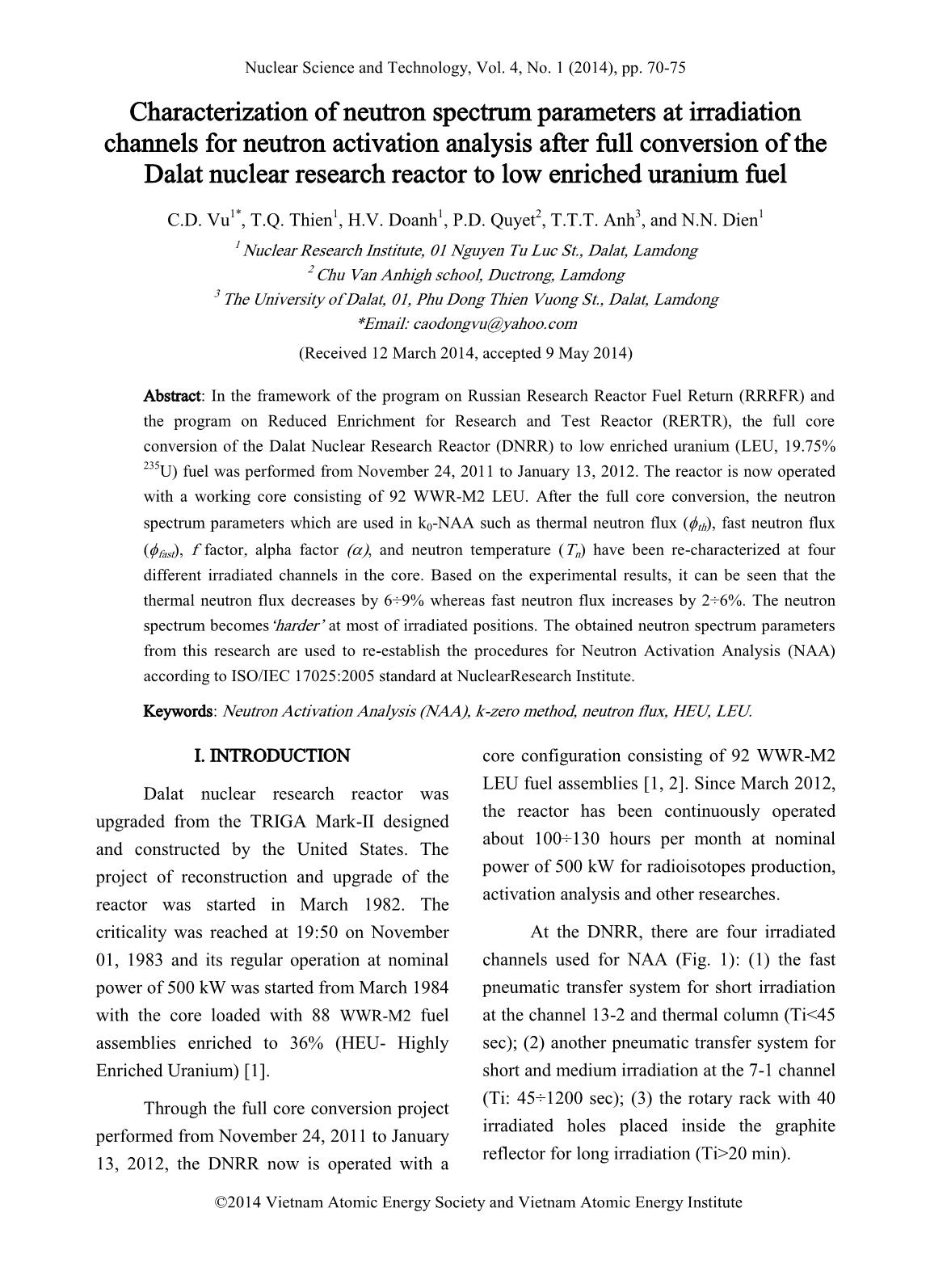
Trang 1
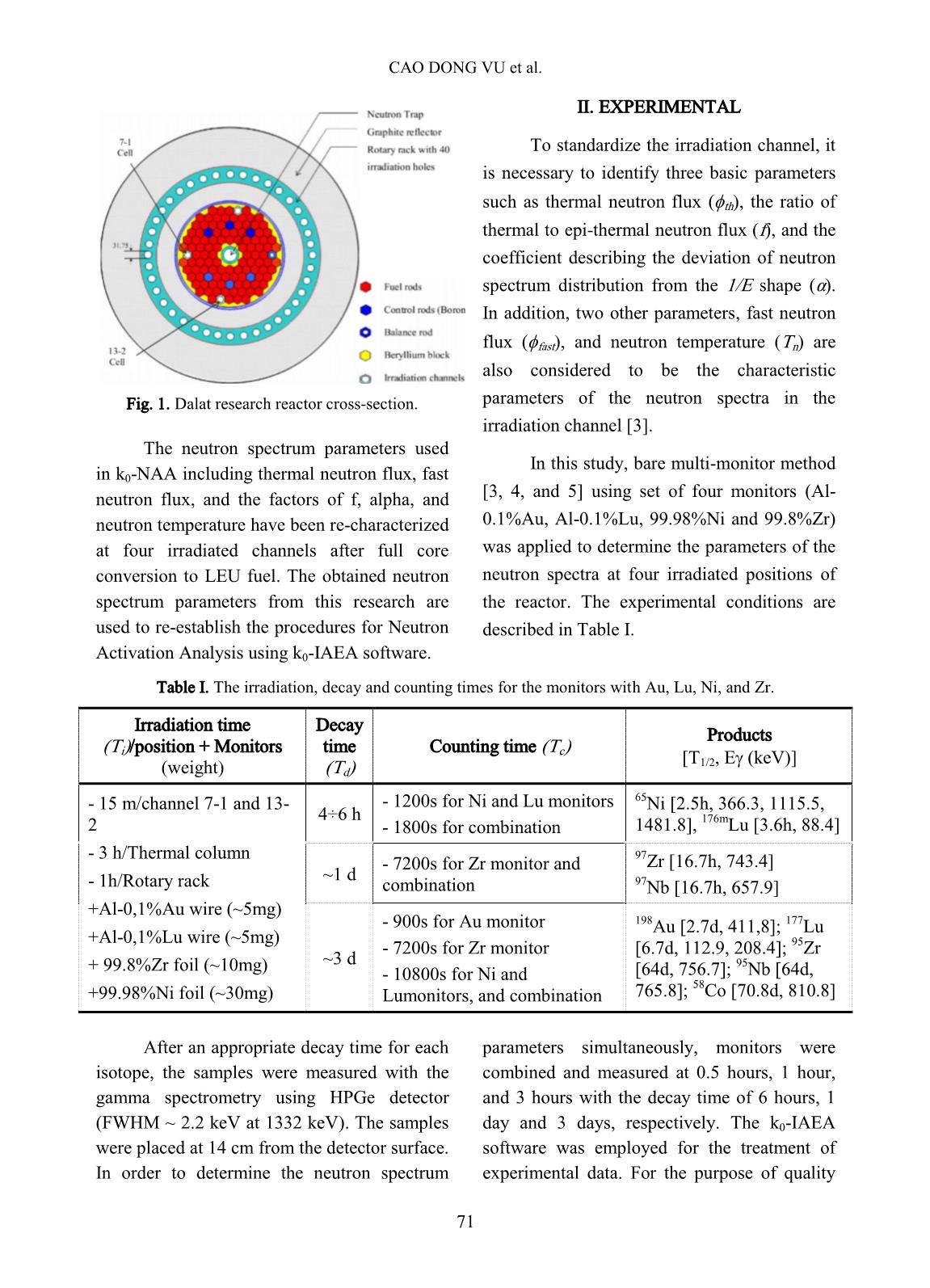
Trang 2
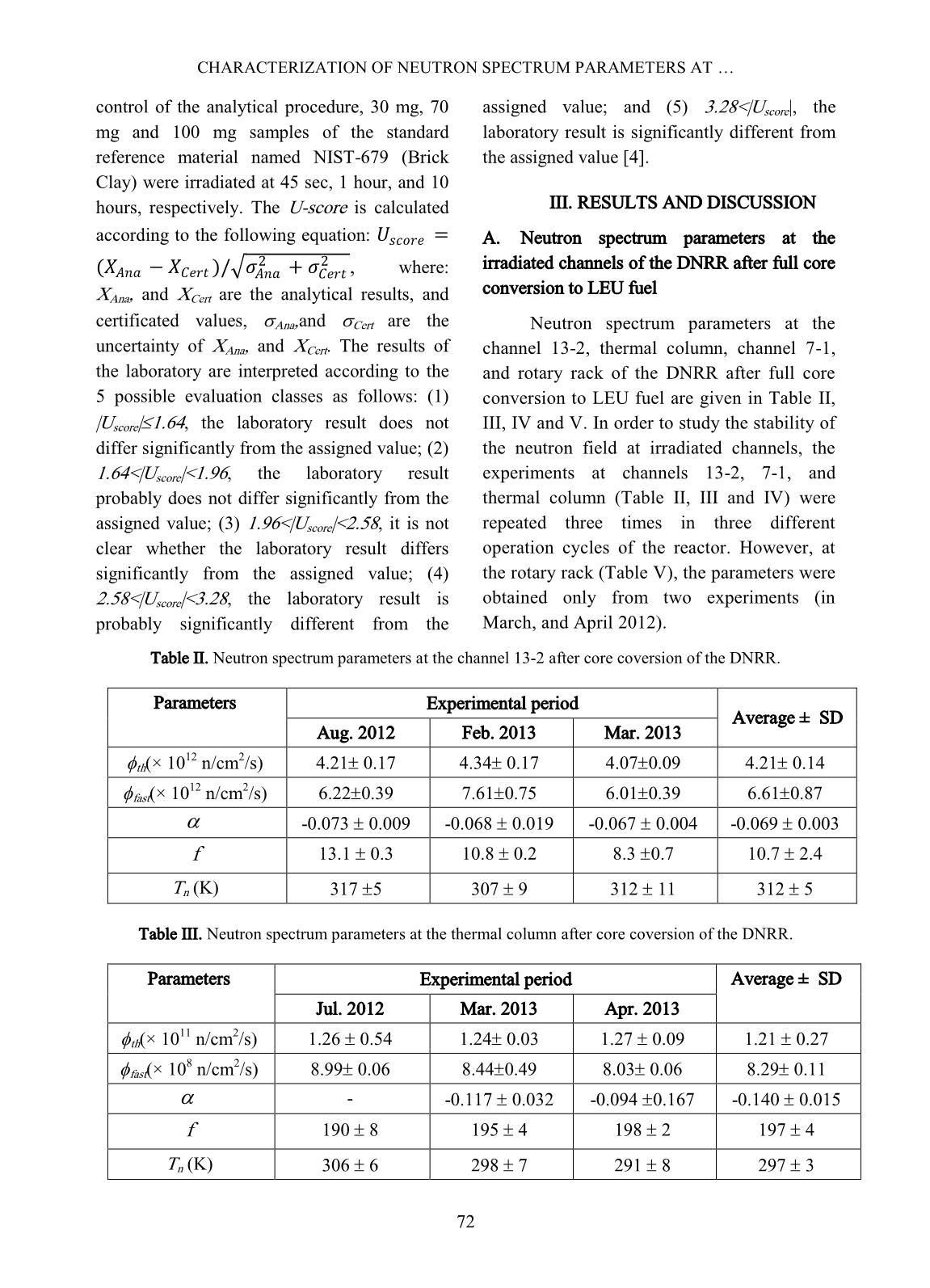
Trang 3
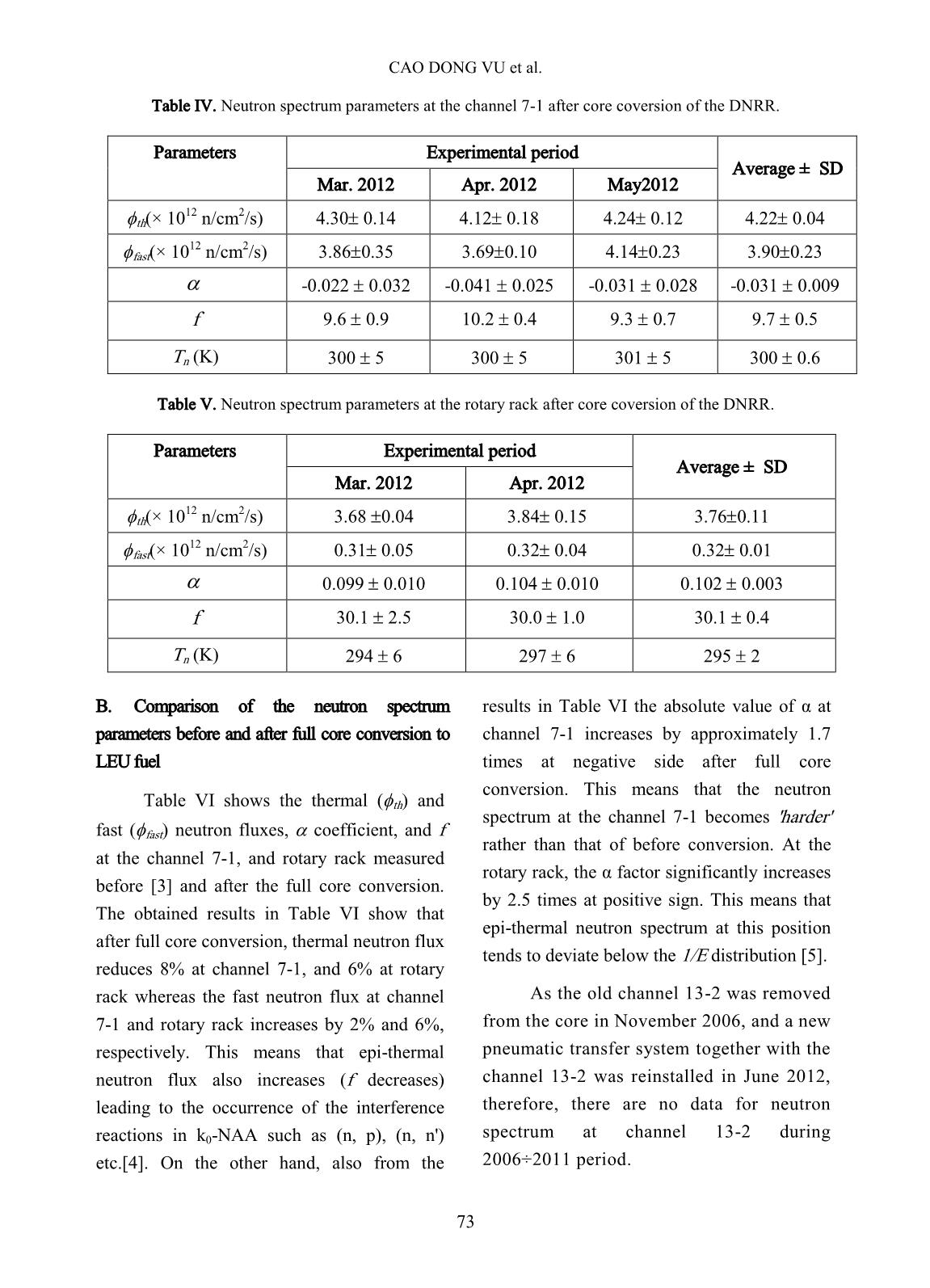
Trang 4
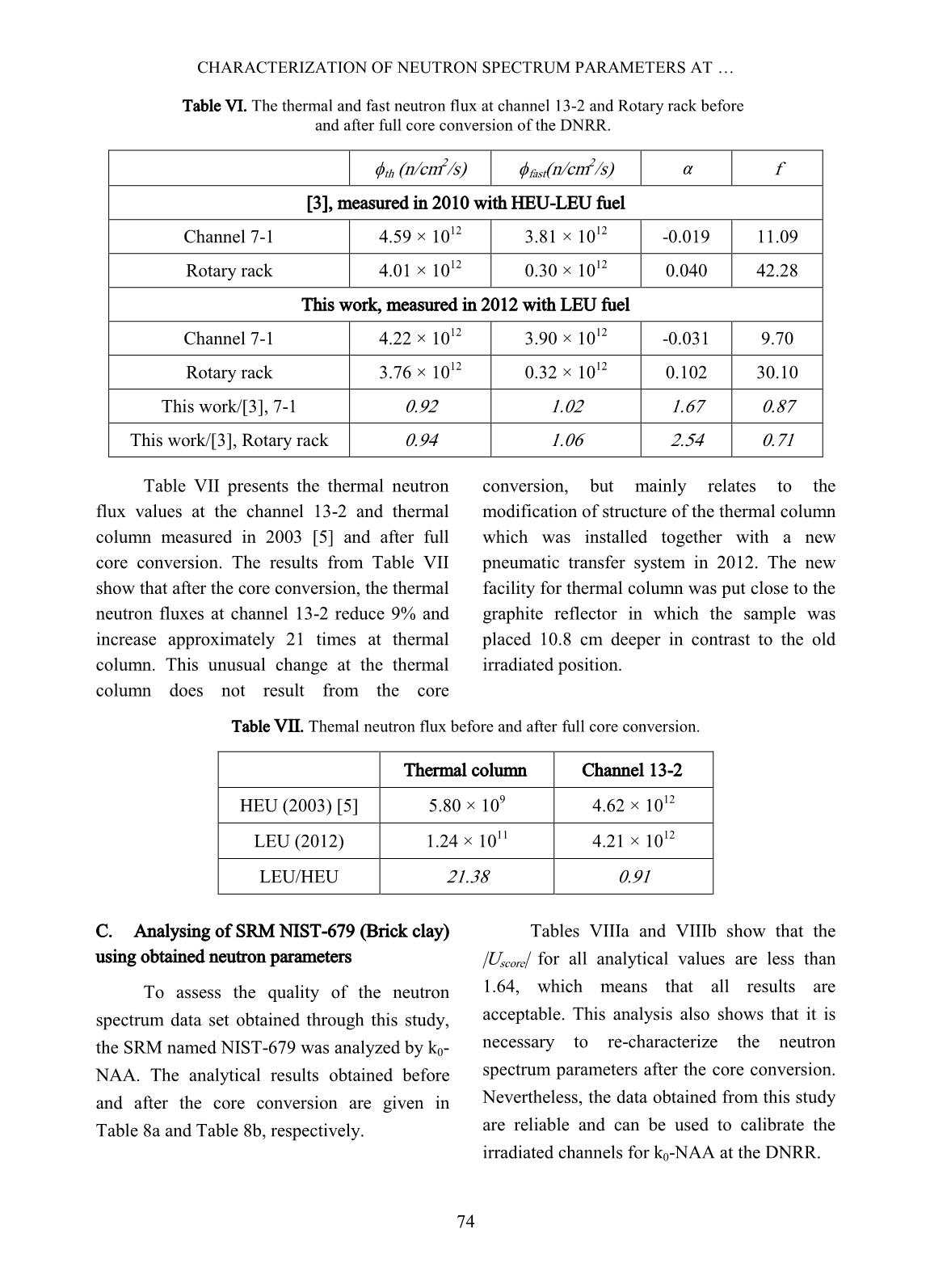
Trang 5
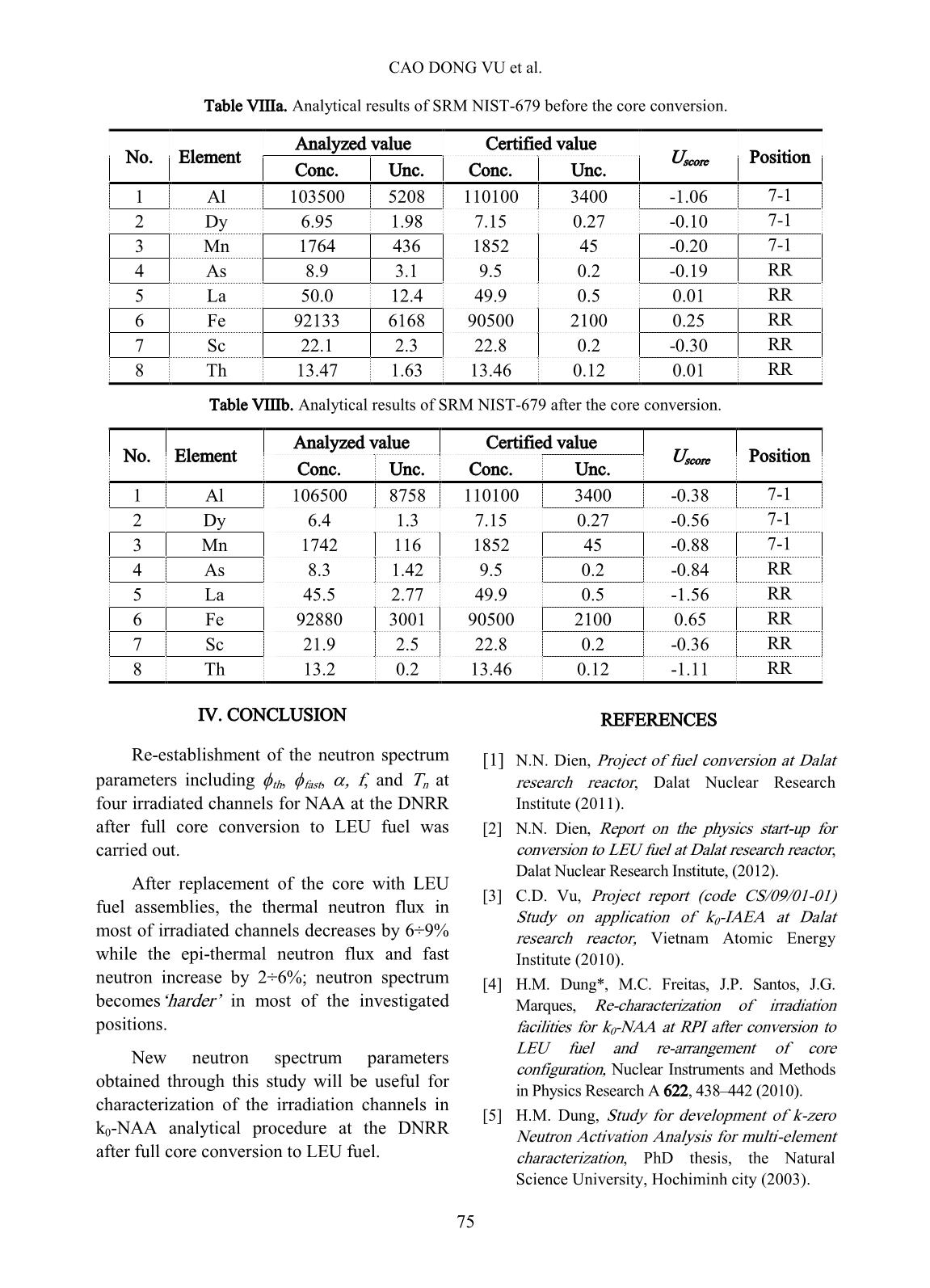
Trang 6
Tóm tắt nội dung tài liệu: Characterization of neutron spectrum parameters at irradiation channels for neutron activation analysis after full conversion of the Dalat nuclear research reactor to low enriched uranium fuel
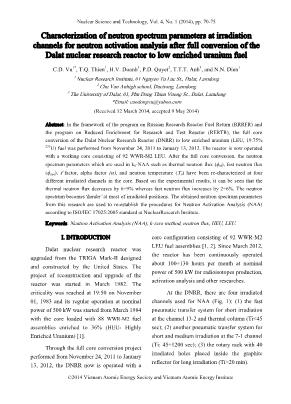
2 WWR-M2 LEU. After the full core conversion, the neutron spectrum parameters which are used in k0-NAA such as thermal neutron flux (th), fast neutron flux (fast), f factor, alpha factor ( ), and neutron temperature (Tn) have been re-characterized at four different irradiated channels in the core. Based on the experimental results, it can be seen that the thermal neutron flux decreases by 6÷9% whereas fast neutron flux increases by 2÷6%. The neutron spectrum becomes‘harder’ at most of irradiated positions. The obtained neutron spectrum parameters from this research are used to re-establish the procedures for Neutron Activation Analysis (NAA) according to ISO/IEC 17025:2005 standard at NuclearResearch Institute. Keywords: Neutron Activation Analysis (NAA), k-zero method, neutron flux, HEU, LEU. I. INTRODUCTION Dalat nuclear research reactor was upgraded from the TRIGA Mark-II designed and constructed by the United States. The project of reconstruction and upgrade of the reactor was started in March 1982. The criticality was reached at 19:50 on November 01, 1983 and its regular operation at nominal power of 500 kW was started from March 1984 with the core loaded with 88 WWR-M2 fuel assemblies enriched to 36% (HEU- Highly Enriched Uranium) [1]. Through the full core conversion project performed from November 24, 2011 to January 13, 2012, the DNRR now is operated with a core configuration consisting of 92 WWR-M2 LEU fuel assemblies [1, 2]. Since March 2012, the reactor has been continuously operated about 100÷130 hours per month at nominal power of 500 kW for radioisotopes production, activation analysis and other researches. At the DNRR, there are four irradiated channels used for NAA (Fig. 1): (1) the fast pneumatic transfer system for short irradiation at the channel 13-2 and thermal column (Ti<45 sec); (2) another pneumatic transfer system for short and medium irradiation at the 7-1 channel (Ti: 45÷1200 sec); (3) the rotary rack with 40 irradiated holes placed inside the graphite reflector for long irradiation (Ti>20 min). ©2014 Vietnam Atomic Energy Society and Vietnam Atomic Energy Institute CAO DONG VU et al. 71 Fig. 1. Dalat research reactor cross-section. The neutron spectrum parameters used in k0-NAA including thermal neutron flux, fast neutron flux, and the factors of f, alpha, and neutron temperature have been re-characterized at four irradiated channels after full core conversion to LEU fuel. The obtained neutron spectrum parameters from this research are used to re-establish the procedures for Neutron Activation Analysis using k0-IAEA software. II. EXPERIMENTAL To standardize the irradiation channel, it is necessary to identify three basic parameters such as thermal neutron flux (th), the ratio of thermal to epi-thermal neutron flux (f), and the coefficient describing the deviation of neutron spectrum distribution from the 1/E shape (α). In addition, two other parameters, fast neutron flux (fast), and neutron temperature (Tn) are also considered to be the characteristic parameters of the neutron spectra in the irradiation channel [3]. In this study, bare multi-monitor method [3, 4, and 5] using set of four monitors (Al- 0.1%Au, Al-0.1%Lu, 99.98%Ni and 99.8%Zr) was applied to determine the parameters of the neutron spectra at four irradiated positions of the reactor. The experimental conditions are described in Table I. Table I. The irradiation, decay and counting times for the monitors with Au, Lu, Ni, and Zr. Irradiation time (Ti)/position + Monitors (weight) Decay time (Td) Counting time (Tc) Products [T1/2, E (keV)] - 15 m/channel 7-1 and 13- 2 - 3 h/Thermal column - 1h/Rotary rack +Al-0,1%Au wire (~5mg) +Al-0,1%Lu wire (~5mg) + 99.8%Zr foil (~10mg) +99.98%Ni foil (~30mg) 4÷6 h - 1200s for Ni and Lu monitors - 1800s for combination 65 Ni [2.5h, 366.3, 1115.5, 1481.8], 176m Lu [3.6h, 88.4] ~1 d - 7200s for Zr monitor and combination 97 Zr [16.7h, 743.4] 97 Nb [16.7h, 657.9] ~3 d - 900s for Au monitor - 7200s for Zr monitor - 10800s for Ni and Lumonitors, and combination 198 Au [2.7d, 411,8]; 177 Lu [6.7d, 112.9, 208.4]; 95 Zr [64d, 756.7]; 95 Nb [64d, 765.8]; 58 Co [70.8d, 810.8] After an appropriate decay time for each isotope, the samples were measured with the gamma spectrometry using HPGe detector (FWHM ~ 2.2 keV at 1332 keV). The samples were placed at 14 cm from the detector surface. In order to determine the neutron spectrum parameters simultaneously, monitors were combined and measured at 0.5 hours, 1 hour, and 3 hours with the decay time of 6 hours, 1 day and 3 days, respectively. The k0-IAEA software was employed for the treatment of experimental data. For the purpose of quality CHARACTERIZATION OF NEUTRON SPECTRUM PARAMETERS AT 72 control of the analytical procedure, 30 mg, 70 mg and 100 mg samples of the standard reference material named NIST-679 (Brick Clay) were irradiated at 45 sec, 1 hour, and 10 hours, respectively. The U-score is calculated according to the following equation: 𝑈𝑠𝑐𝑜𝑟𝑒 = (𝑋𝐴𝑛𝑎 − 𝑋𝐶𝑒𝑟𝑡 )/ 𝜎𝐴𝑛𝑎 2 + 𝜎𝐶𝑒𝑟𝑡 2 , where: XAna, and XCert are the analytical results, and certificated values, Ana,and Cert are the uncertainty of XAna, and XCert. The results of the laboratory are interpreted according to the 5 possible evaluation classes as follows: (1) |Uscore| 1.64, the laboratory result does not differ significantly from the assigned value; (2) 1.64<|Uscore|<1.96, the laboratory result probably does not differ significantly from the assigned value; (3) 1.96<|Uscore|<2.58, it is not clear whether the laboratory result differs significantly from the assigned value; (4) 2.58<|Uscore|<3.28, the laboratory result is probably significantly different from the assigned value; and (5) 3.28<|Uscore|, the laboratory result is significantly different from the assigned value [4]. III. RESULTS AND DISCUSSION A. Neutron spectrum parameters at the irradiated channels of the DNRR after full core conversion to LEU fuel Neutron spectrum parameters at the channel 13-2, thermal column, channel 7-1, and rotary rack of the DNRR after full core conversion to LEU fuel are given in Table II, III, IV and V. In order to study the stability of the neutron field at irradiated channels, the experiments at channels 13-2, 7-1, and thermal column (Table II, III and IV) were repeated three times in three different operation cycles of the reactor. However, at the rotary rack (Table V), the parameters were obtained only from two experiments (in March, and April 2012). Table II. Neutron spectrum parameters at the channel 13-2 after core coversion of the DNRR. Parameters Experimental period Average ± SD Aug. 2012 Feb. 2013 Mar. 2013 th(× 10 12 n/cm 2 /s) 4.21 0.17 4.34 0.17 4.07 0.09 4.21 0.14 fast(× 10 12 n/cm 2 /s) 6.22 0.39 7.61 0.75 6.01 0.39 6.61 0.87 -0.073 0.009 -0.068 0.019 -0.067 0.004 -0.069 0.003 f 13.1 0.3 10.8 0.2 8.3 0.7 10.7 2.4 Tn (K) 317 5 307 9 312 11 312 5 Table III. Neutron spectrum parameters at the thermal column after core coversion of the DNRR. Parameters Experimental period Average ± SD Jul. 2012 Mar. 2013 Apr. 2013 th(× 10 11 n/cm 2 /s) 1.26 0.54 1.24 0.03 1.27 0.09 1.21 0.27 fast(× 10 8 n/cm 2 /s) 8.99 0.06 8.44 0.49 8.03 0.06 8.29 0.11 - -0.117 0.032 -0.094 0.167 -0.140 0.015 f 190 8 195 4 198 2 197 4 Tn (K) 306 6 298 7 291 8 297 3 CAO DONG VU et al. 73 Table IV. Neutron spectrum parameters at the channel 7-1 after core coversion of the DNRR. Parameters Experimental period Average ± SD Mar. 2012 Apr. 2012 May2012 th(× 10 12 n/cm 2 /s) 4.30 0.14 4.12 0.18 4.24 0.12 4.22 0.04 fast(× 10 12 n/cm 2 /s) 3.86 0.35 3.69 0.10 4.14 0.23 3.90 0.23 -0.022 0.032 -0.041 0.025 -0.031 0.028 -0.031 0.009 f 9.6 0.9 10.2 0.4 9.3 0.7 9.7 0.5 Tn (K) 300 5 300 5 301 5 300 0.6 Table V. Neutron spectrum parameters at the rotary rack after core coversion of the DNRR. Parameters Experimental period Average ± SD Mar. 2012 Apr. 2012 th(× 10 12 n/cm 2 /s) 3.68 0.04 3.84 0.15 3.76 0.11 fast(× 10 12 n/cm 2 /s) 0.31 0.05 0.32 0.04 0.32 0.01 0.099 0.010 0.104 0.010 0.102 0.003 f 30.1 2.5 30.0 1.0 30.1 0.4 Tn (K) 294 6 297 6 295 2 B. Comparison of the neutron spectrum parameters before and after full core conversion to LEU fuel Table VI shows the thermal (th) and fast (fast) neutron fluxes, coefficient, and f at the channel 7-1, and rotary rack measured before [3] and after the full core conversion. The obtained results in Table VI show that after full core conversion, thermal neutron flux reduces 8% at channel 7-1, and 6% at rotary rack whereas the fast neutron flux at channel 7-1 and rotary rack increases by 2% and 6%, respectively. This means that epi-thermal neutron flux also increases (f decreases) leading to the occurrence of the interference reactions in k0-NAA such as (n, p), (n, n') etc.[4]. On the other hand, also from the results in Table VI the absolute value of α at channel 7-1 increases by approximately 1.7 times at negative side after full core conversion. This means that the neutron spectrum at the channel 7-1 becomes 'harder' rather than that of before conversion. At the rotary rack, the α factor significantly increases by 2.5 times at positive sign. This means that epi-thermal neutron spectrum at this position tends to deviate below the 1/E distribution [5]. As the old channel 13-2 was removed from the core in November 2006, and a new pneumatic transfer system together with the channel 13-2 was reinstalled in June 2012, therefore, there are no data for neutron spectrum at channel 13-2 during 2006÷2011 period. CHARACTERIZATION OF NEUTRON SPECTRUM PARAMETERS AT 74 Table VI. The thermal and fast neutron flux at channel 13-2 and Rotary rack before and after full core conversion of the DNRR. th (n/cm 2/s) fast(n/cm 2/s) α f [3], measured in 2010 with HEU-LEU fuel Channel 7-1 4.59 × 10 12 3.81 × 10 12 -0.019 11.09 Rotary rack 4.01 × 10 12 0.30 × 10 12 0.040 42.28 This work, measured in 2012 with LEU fuel Channel 7-1 4.22 × 10 12 3.90 × 10 12 -0.031 9.70 Rotary rack 3.76 × 10 12 0.32 × 10 12 0.102 30.10 This work/[3], 7-1 0.92 1.02 1.67 0.87 This work/[3], Rotary rack 0.94 1.06 2.54 0.71 Table VII presents the thermal neutron flux values at the channel 13-2 and thermal column measured in 2003 [5] and after full core conversion. The results from Table VII show that after the core conversion, the thermal neutron fluxes at channel 13-2 reduce 9% and increase approximately 21 times at thermal column. This unusual change at the thermal column does not result from the core conversion, but mainly relates to the modification of structure of the thermal column which was installed together with a new pneumatic transfer system in 2012. The new facility for thermal column was put close to the graphite reflector in which the sample was placed 10.8 cm deeper in contrast to the old irradiated position. Table VII. Themal neutron flux before and after full core conversion. Thermal column Channel 13-2 HEU (2003) [5] 5.80 × 10 9 4.62 × 10 12 LEU (2012) 1.24 × 10 11 4.21 × 10 12 LEU/HEU 21.38 0.91 C. Analysing of SRM NIST-679 (Brick clay) using obtained neutron parameters To assess the quality of the neutron spectrum data set obtained through this study, the SRM named NIST-679 was analyzed by k0- NAA. The analytical results obtained before and after the core conversion are given in Table 8a and Table 8b, respectively. Tables VIIIa and VIIIb show that the |Uscore| for all analytical values are less than 1.64, which means that all results are acceptable. This analysis also shows that it is necessary to re-characterize the neutron spectrum parameters after the core conversion. Nevertheless, the data obtained from this study are reliable and can be used to calibrate the irradiated channels for k0-NAA at the DNRR. CAO DONG VU et al. 75 Table VIIIa. Analytical results of SRM NIST-679 before the core conversion. No. Element Analyzed value Certified value Uscore Position Conc. Unc. Conc. Unc. 1 Al 103500 5208 110100 3400 -1.06 7-1 2 Dy 6.95 1.98 7.15 0.27 -0.10 7-1 3 Mn 1764 436 1852 45 -0.20 7-1 4 As 8.9 3.1 9.5 0.2 -0.19 RR 5 La 50.0 12.4 49.9 0.5 0.01 RR 6 Fe 92133 6168 90500 2100 0.25 RR 7 Sc 22.1 2.3 22.8 0.2 -0.30 RR 8 Th 13.47 1.63 13.46 0.12 0.01 RR Table VIIIb. Analytical results of SRM NIST-679 after the core conversion. No. Element Analyzed value Certified value Uscore Position Conc. Unc. Conc. Unc. 1 Al 106500 8758 110100 3400 -0.38 7-1 2 Dy 6.4 1.3 7.15 0.27 -0.56 7-1 3 Mn 1742 116 1852 45 -0.88 7-1 4 As 8.3 1.42 9.5 0.2 -0.84 RR 5 La 45.5 2.77 49.9 0.5 -1.56 RR 6 Fe 92880 3001 90500 2100 0.65 RR 7 Sc 21.9 2.5 22.8 0.2 -0.36 RR 8 Th 13.2 0.2 13.46 0.12 -1.11 RR IV. CONCLUSION Re-establishment of the neutron spectrum parameters including th, fast, , f, and Tn at four irradiated channels for NAA at the DNRR after full core conversion to LEU fuel was carried out. After replacement of the core with LEU fuel assemblies, the thermal neutron flux in most of irradiated channels decreases by 6÷9% while the epi-thermal neutron flux and fast neutron increase by 2÷6%; neutron spectrum becomes‘harder’ in most of the investigated positions. New neutron spectrum parameters obtained through this study will be useful for characterization of the irradiation channels in k0-NAA analytical procedure at the DNRR after full core conversion to LEU fuel. REFERENCES [1] N.N. Dien, Project of fuel conversion at Dalat research reactor, Dalat Nuclear Research Institute (2011). [2] N.N. Dien, Report on the physics start-up for conversion to LEU fuel at Dalat research reactor, Dalat Nuclear Research Institute, (2012). [3] C.D. Vu, Project report (code CS/09/01-01) Study on application of k0-IAEA at Dalat research reactor, Vietnam Atomic Energy Institute (2010). [4] H.M. Dung*, M.C. Freitas, J.P. Santos, J.G. Marques, Re-characterization of irradiation facilities for k0-NAA at RPI after conversion to LEU fuel and re-arrangement of core configuration, Nuclear Instruments and Methods in Physics Research A 622, 438–442 (2010). [5] H.M. Dung, Study for development of k-zero Neutron Activation Analysis for multi-element characterization, PhD thesis, the Natural Science University, Hochiminh city (2003).
File đính kèm:
 characterization_of_neutron_spectrum_parameters_at_irradiati.pdf
characterization_of_neutron_spectrum_parameters_at_irradiati.pdf

